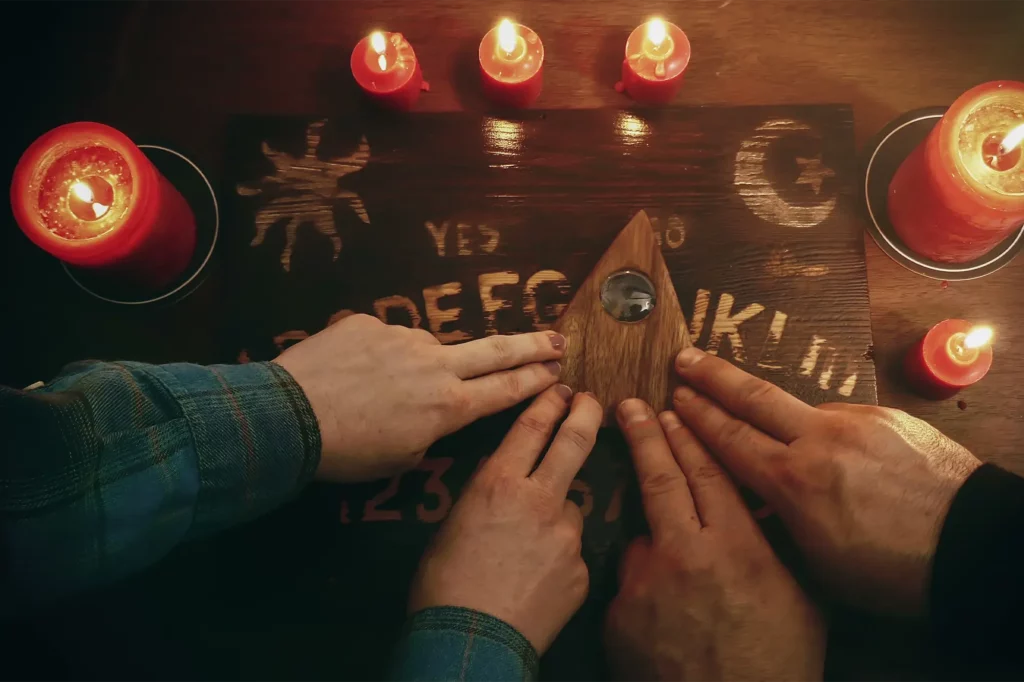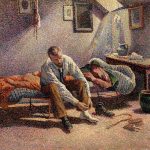The Ouija board.
Few objects in modern culture carry such a perfect mix of curiosity and caution. I first saw one in my aunt’s attic back in Detroit, late summer of ’79. The box was covered in a fine coat of dust, the words “Mystifying Oracle” printed in a style that seemed like it belonged to another time. Some folks treat it like a harmless party game. Others, often the ones with their own stories, will tell you it’s not a game at all.
What the Ouija Board Is, and Isn’t
The Basics
A Ouija board is a flat board marked with the alphabet, numbers zero through nine, and simple words like “yes,” “no,” and “goodbye.” It comes with a small, heart-shaped device called a planchette. Players place their fingertips lightly on the planchette, ask a question, and watch it slide across the board to spell out an answer.
To some, it’s a parlor trick with a spooky reputation. To others, it’s a communication tool, one that should be approached with care. What’s undeniable is that it occupies a strange cultural space, balanced between the shelves of toy stores and the whispered stories of ghost hunters.
Does It Really Work?
The short answer: it depends on what you believe. Believers see the board as a bridge to the spirit world, a way to send questions out into the dark and receive answers back. Skeptics point to the ideomotor effect, a psychological phenomenon where unconscious muscle movements guide the planchette. Yet even those with both feet planted firmly in science admit that, in the right setting, the experience can feel unsettlingly real.
A Short History of the “Mystifying Oracle”
The Ouija board’s modern design was patented in 1891, but the idea of communicating with the unseen is far older. Its roots can be traced to practices like automatic writing, used in various cultures for centuries. The board’s popularity surged in the early 20th century, especially after World War I and the Spanish flu pandemic, when grief was a daily companion in countless households.
For many, it wasn’t about summoning strangers from beyond, it was about reaching for the familiar voices they had lost. That longing gave the Ouija board its enduring emotional charge.
Myths, Fears, and the Question of Danger
Is It a Portal?
In spiritualist circles, the Ouija board is often treated as a doorway, one that opens when you begin a session and should be closed before you leave it. That’s why “goodbye” is more than just a word printed in the corner; it’s a ritual. Skeptics call this symbolism, but even symbols can carry weight. The act of closing a session helps users feel a sense of control, whether they believe in spirits or not.
Are All Experiences Dark?
Despite what horror movies suggest, not every Ouija session ends with chaos. Some users report calm, even heartwarming encounters, simple messages of love or reassurance from someone they once knew. Others speak of stranger moments: the planchette spelling out unknown names, cryptic sentences, or giving answers that chill the room into silence. The truth may lie somewhere between imagination and something we can’t yet explain.
Could It Be Dangerous?
Stories of misfortune after a Ouija session are easy to find. Lights flickering, vivid nightmares, objects out of place in the morning, events that make people swear they brought something back with them. Science will tell you it’s coincidence, the power of suggestion playing tricks on a tense mind. Believers say there’s more at work. Either way, fear alone can be a potent and dangerous force.
Using a Ouija Board Safely
If you decide to try, consider a few common practices to keep the experience steady and respectful:
Treat the process and any presence you believe in with courtesy.
Always close the session by saying “goodbye.”
Avoid using the board alone. Shared energy can feel safer.
Stay away from heavy or negative places like graveyards or abandoned sites.
Don’t ask questions that invite fear, like predicting someone’s death.
These aren’t strict rules, but they’re the kind of folk wisdom that’s been passed along for decades by people who’ve seen sessions go sideways.
The Science Behind the Mystery
The ideomotor effect is the most widely accepted explanation for Ouija phenomena. It describes the way our muscles can make small, unconscious movements based on expectations in the mind. You might not think you’re pushing, but your brain could be steering your hands toward answers it anticipates, or fears. The result can feel startling, especially when the words formed seem to carry meaning you never intended.
If You Want to Let One Go
Maybe you’ve decided the board isn’t for you. In that case, you have options. You can store it away, give it to someone else, bury it, or even burn it, though some traditions warn the last choice could stir up unwanted energy. Ultimately, it’s a personal decision, one that should be guided by your own comfort and beliefs.
Game or Gateway?
Today, Hasbro markets the Ouija board as a game, sitting alongside puzzles and card decks. Yet in spiritual circles, it remains a respected sometimes feared tool for divination. The truth might be that it’s both, shaped entirely by what you bring to it.
Perhaps that’s the Ouija board’s greatest mystery: it reflects our own questions back to us, waiting patiently for the moment we dare to ask them out loud.
The post Ouija Board Mysteries: Truth, Myths & How to Use It Safely appeared first on askAstrology.


